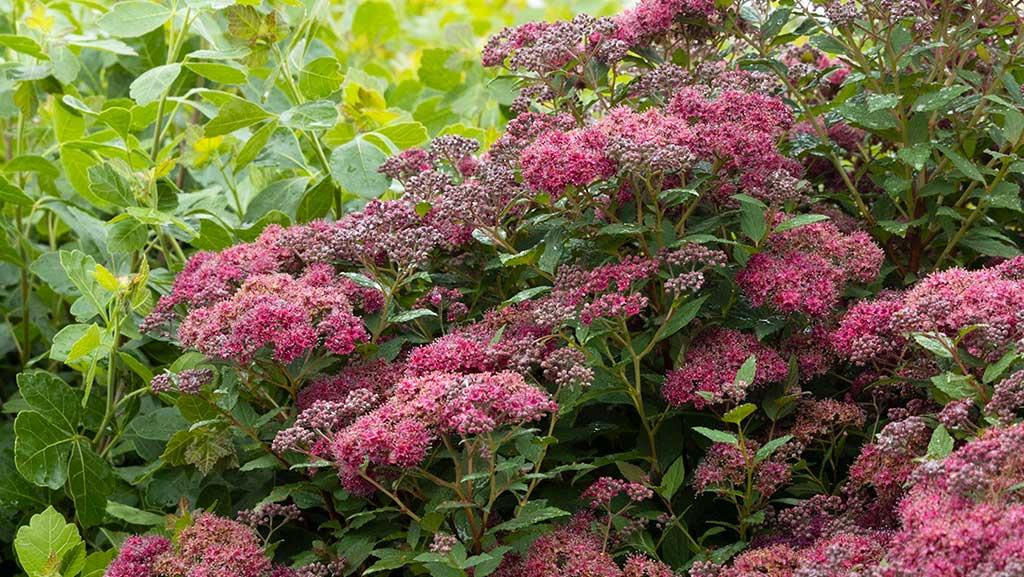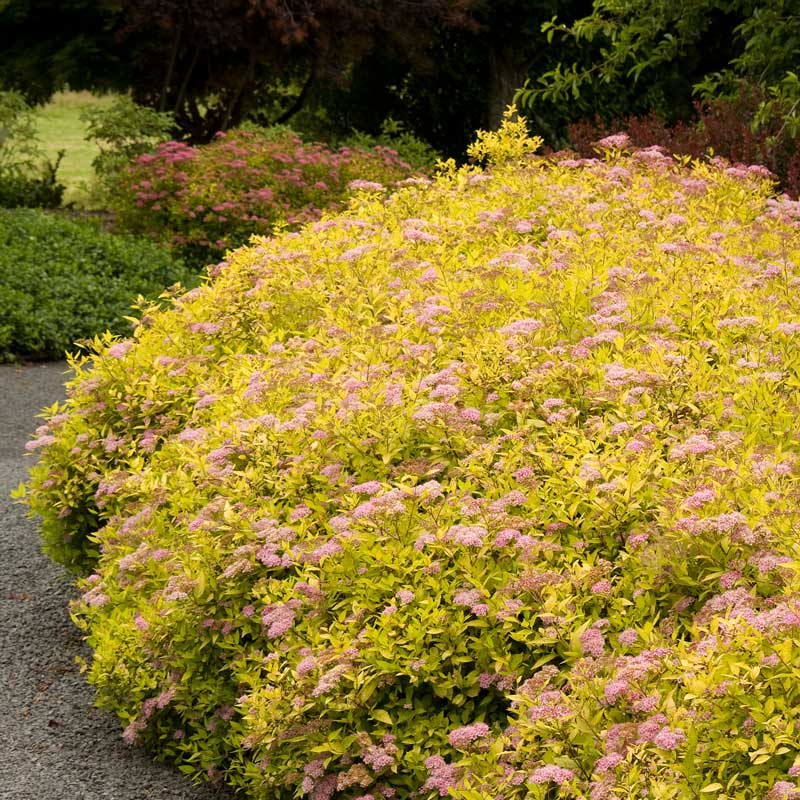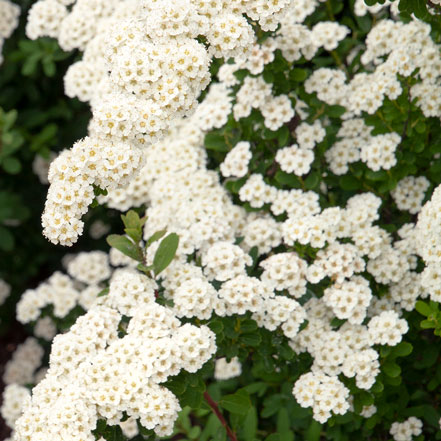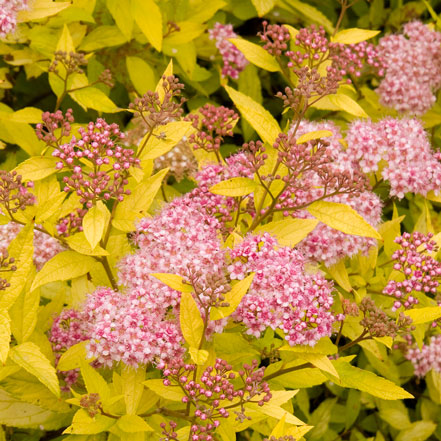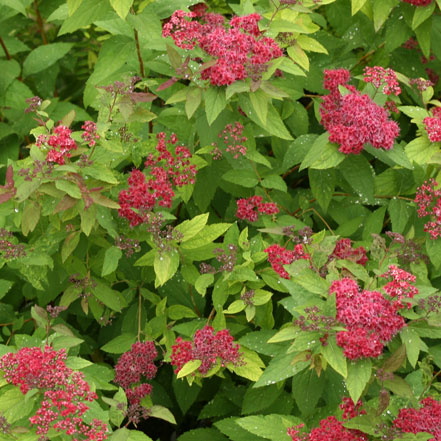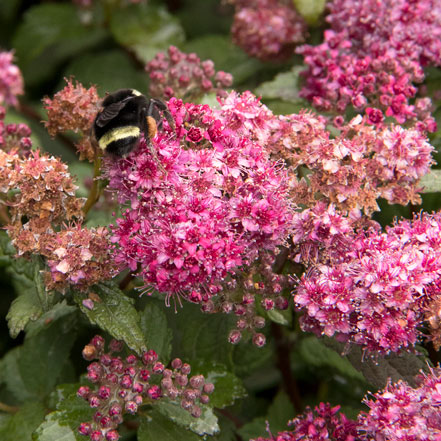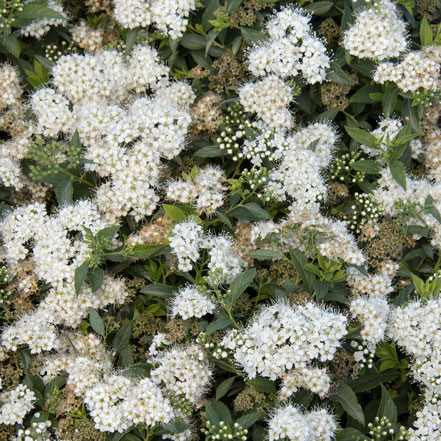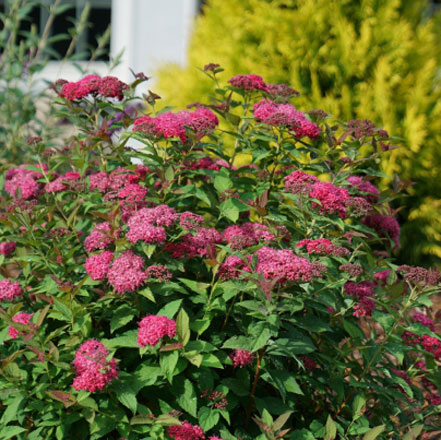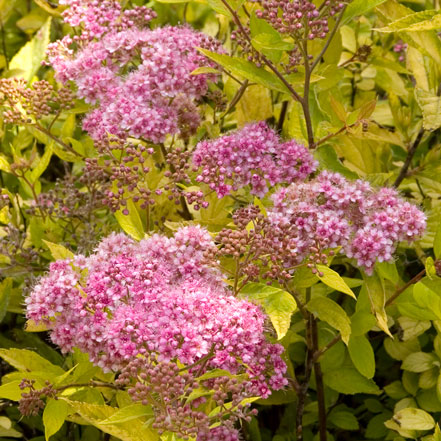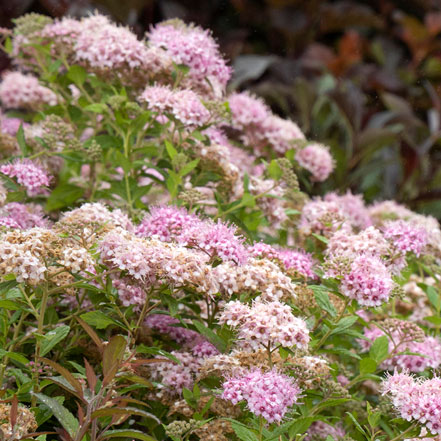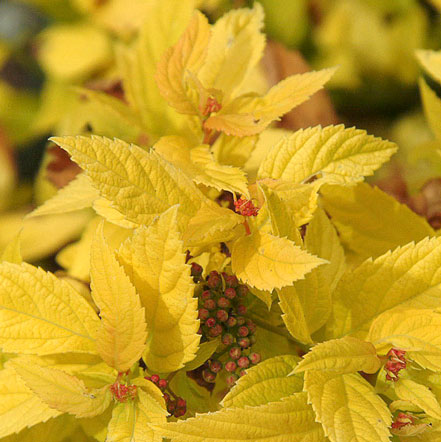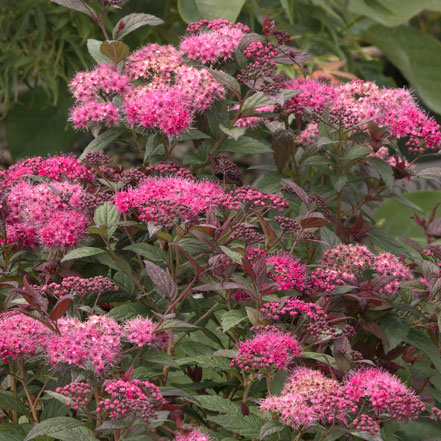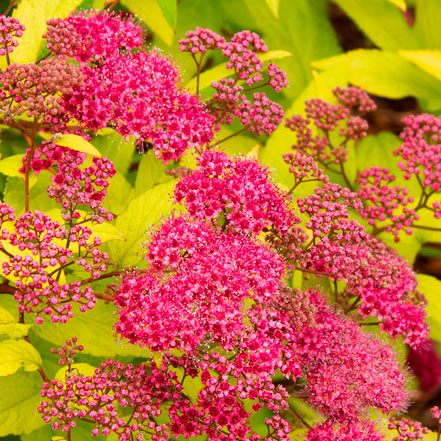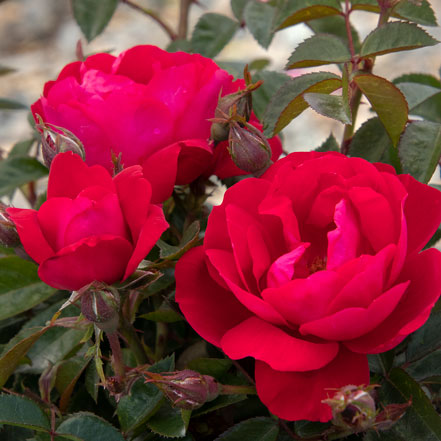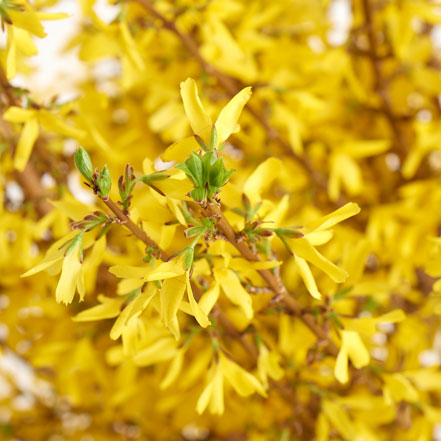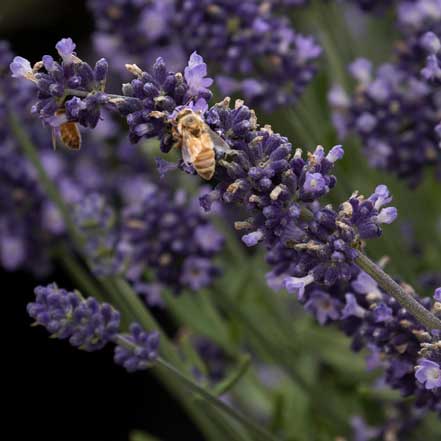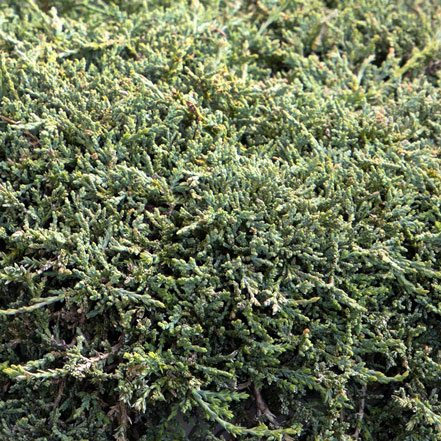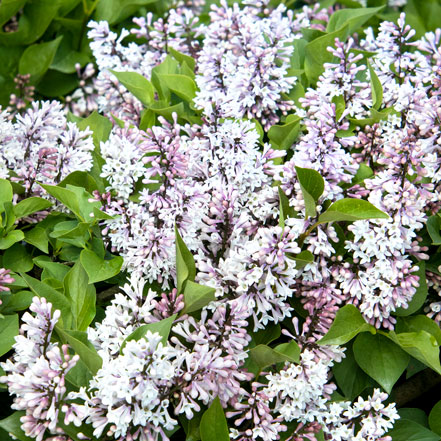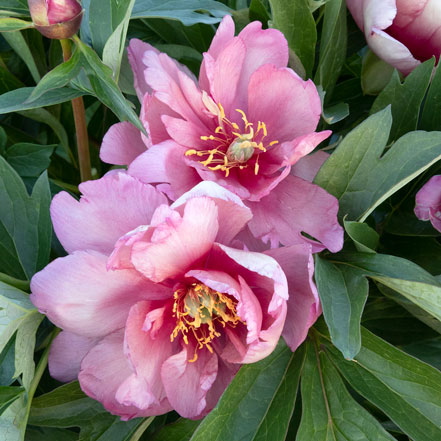Ah, Spirea. So many reasons to find a spot for you in the garden.
A staple of easy-care landscapes and a favorite of time-crunched gardeners everywhere. This woody, deciduous spring and summer blooming (or with newer varieties, floral flushes spring until fall) shrub checks all boxes. Tolerant of most soil conditions, spirea has lots of named cultivars and varieties to choose from. It boasts foliage in shades of green, lime, orange, and purple, and flowers in white, red or shades of pink. It is beloved by bees, butterflies and hummingbirds, and ranges in height from 1' to 6' tall. Added bonus: spirea is typically ignored by deer and rabbits.
Sound good? Read on!
PHOTOS: Doreen Wynja
What is Spirea?
Spirea is a group of woody smaller leafed shrubs. Depending upon type, bloom on long, arching or on more compact stems in either spring or summer. Or, in flushes throughout the season. They are typically classified as spring or summer blooming. Early-spring blooming spirea most often has a delicate cascading habit with large clusters of white flowers on arching branches. While later in the spring, look for a broader range of colors on a more diverse size shrub. Summer blooming spirea are usually a more upright shape with beautiful pink, white or red flowers.
Spirea's foliage is also a standout—depending on the variety it can be green or blue-green. They can also morph into different shades from spring to fall. All spirea are deciduous, losing their foliage in fall.
The spirea you are probably most familiar with is a bridal wreath. This is a larger type that stuns in spring with an unforgettable display of cascading branches smothered in white flowers. More compact types, such as the japonicas, are indispensable team players in foundations, middle-to-front of borders, and even in containers. Pairing well with lots of other shrubs (see below). They provide simple, elegant green filler when not in bloom. Thus amplifying the impact of summer bloomers such as roses and hydrangeas.
While there are quite a few species of spirea (80+!), here the ones you are most likely to find readily available at garden centers:
Japanese spirea (Spiraea japonica). Offering the greatest range of sizes (dwarf right up to 5' or taller) and flower and leaf colors. Japanese spirea produces lavish clusters of white, light pink, rosy-red or purple flowers in late spring and summer. Finely textured green or blue-green foliage is most typical. However, this is where to look for cultivars with luminous yellow or chartreuse foliage that changes color throughout the season.
Bridal wreath spirea (Spiraea prunifolia). Gardeners have planted this old-fashioned classic for generations. (If you have an older bridal wreath in your garden, lucky you!) Seduced by the brilliant display of double white flowers that cover bare branches in early spring. Give this one room to do its thing. It reaches 4 to 8 feet high and 6 to 8 feet wide. Those arching branches benefit from negative space.
Nippon spirea (Spiraea nipponica). Nippon spirea, commonly known as snowmound spirea, is a relatively smaller, upright, mounded shrub. It reaches 4 to 5 feet tall and wide. Look for a late spring frothy shower of clustered, small, white flowers. They cover the limbs like a mound of snow followed by signature deep blue-green leaves during the summer months.
Spirea Shrub Basics
Zones: Most spirea are hardy from zones 4-8, but some varieties are notably more heat and cold tolerant.
Size range: 1 to 8 feet tall and up to 6 feet wide depending on specific variety.
Light conditions: While many types of spirea can tolerate partial shade, for best foliage and flower color provide full sun. (At least 6 hours of direct light daily).
Soil: Well-drained, neutral to slightly acidic soil (pH 6 to 7).
Bloom period: Spirea bushes are classified as spring-blooming (budding out in May and June). Or, summer-blooming (budding out in July and August) varieties. Some newer varieties boast blooms in spring with flushes into fall.
Growth rate: Depending on conditions, expect moderate to fast growth.
Wildlife benefits: Attracts bees, hummingbirds and butterflies; deer resistant.
Invasive: Some species (particularly the japonica varieties) can seed aggressively in parts of the country. Check with local experts for regionally appropriate varieties. Or, select a newer cultivar that has been developed to be seedless and non-invasive. Monrovia only ships plants where they are non-invasive.
How to Plant Spirea Shrubs
When: As with most woody shrubs, the best time to plant is spring or fall. If transplanting, doing so in fall is recommended.
Where: Spirea can tolerate most soils but they do not like wet feet, so choose a location that drains well. Spirea blooms best with at least 6 hours of direct sun daily.
How: Dig a hole twice the width of the pot. Set plant in hole so top of root ball is slightly above ground level. Back fill soil, and water thoroughly to settle the soil. Add a 2-3" layer of mulch, pulling away from the stems.
Spacing: Refer to the label for mature size. Some spirea can get very wide over time and need elbow room to be at their most impressive. Smaller spirea used in borders should be spaced closer; the same is true for taller spirea utilized for flowering hedges.
How to Care for Spirea
Spirea are some of the least-fussy shrubs you are likely to encounter. However, like all plants, they do have needs!
- Feeding and mulching
- Watering
- Pruning
- Pests and diseases
Food: Monrovia plants have been container-grown in a custom soil blend with added mycorrhizae. Once planted in the garden, they will naturally get off to a great start. Add balanced fertilizer at the time of planting. Once established in the garden, side-dress with a balanced fertilizer and a light layer of organic compost in spring.
Water: Keep newly planted spirea well-watered until they become established. Mature spireas are wonderfully drought tolerant. Therefore, only water when the soil becomes dry due to lack of rain or sustained drought. Spireas don’t like wet feet, so avoid oversaturating the soil.
Pruning: Spring bloomers can be pruned right after the flowers are spent. Prune summer-bloomer in late winter or in spring. Remove dead wood and trim old or weak canes of spring varieties to the ground annually. Spireas are fast growers and will recover quickly, so do not be afraid to cut back. After flowers on any spirea fade, remove them for a subsequent flush of blooms.
Pest and diseases: Like other members of the rose family, spireas are susceptible to various pests and diseases. (But most are not serious). Watch for leaf spot and powdery mildew as well as aphids. This should be treated early with insecticidal soap, repeating as needed.
6 Spring-Blooming Spirea Varieties
Magic Carpet
Spirea
Compact, mounded with pink flowers and foliage that turns rich russet red in fall. Up to 2' tall and wide. Zone: 4 - 9
Best for: borders, containers
Double Play® Red
Spirea
Rich burgundy early spring foliage followed by crimson-red late spring blooms. Up to 3' tall and wide. Zone: 3 - 8
Best for: massed, mixed borders
PHOTO: Proven Winners
Lil' Flirt
Spirea
Tough, compact with red new foliage, pink flowers in spring, and again in summer. Up to 3' tall and wide. Zone: 4 - 9
Best for: low borders, pots
Lil' Sizzle®
Spirea
Tough and compact with orange new foliage and pink flowers in spring, and again in summer. Up to 3' tall and wide. Zone 4 - 9
Best for: cutting gardens, pots
Yeti™ Japanese
Spirea
Compact repeat white-flowering bloomer with tidy appearance throughout season. Up to 3' tall and wide. Zone: 4 - 9
Best for: borders, urban gardens
6 Summer-Blooming Spirea Varieties
Double Play Doozie®
Spirea
Foliage emerges red, followed by purple-red flowers into fall. Up to 3' tall and wide. Zone: 3 - 9
Best for: Mixed borders, pots
PHOTO: Proven Winners
Limemound®
Spirea
Lovely panicles of soft pink blooms on lime-green summer foliage; brilliant fall color. Up to 4' tall and wide. Zone: 3 - 9
Best for: bright accents, borders
Little Princess
Spirea
Grows low and wide with rose pink blooms against mint green foliage. Up to 3' tall, 6' wide. Zone: 4 - 9
Best for: low hedges, accents
Golden Sunrise®
Spirea
Yellow new foliage turns coppery orange in fall; pink flowers throughout summer. Up to 4' tall and wide. Zone: 4 - 9
Best for: front and mid-borders
Walberton's® Plumtastic
Spirea
Blooms flush continuously summer into fall. Up to 16" tall and wide. Zone: 4 - 9
Best for: low edging, pots
Tips for Designing with Spirea Shrubs
A shrub that comes in sizes from 1' to 6'+ opens up a world of possibilities for landscape use. When selecting a spirea for your garden remember that these shrubs not only come in a range of sizes. But, they also come in various forms—some are upright, others have a cascading form.
- Add to borders where you need some early-to-midseason color and where a bright display of fall color will be welcome.
- While not all spirea are right for containers , there are smaller varieties that settle in nicely. (Adding some trailing perennials or annuals revs the romance).
- Layer into mixed shrub plantings in groups of 3 to 5 shrubs. Then surround with different types of plants for contrast. (We love hydrangeas, roses, clethra, laurels, and spikes of lavender. Also perennials such as coneflowers or annuals like SunBelievable® Brown Eyed Girl Helianthus)
- Play up the elegant finely textured green to blue-green spring/summer foliage. Do so by contrasting with plants that have red or purple foliage such as loropetalum, smokebush, and photinia.
- If year-round privacy is not an issue, taller varieties of spirea make for a beautiful, dense flowering hedge. Where you have the room, consider a hedge of bridal veil spirea for sheer impact.
- Mid-sized spirea are an ideal filler plant for the middle of a mixed border. Smaller types can be used at the very front of a border. Adding in a few conifers where soil conditions are appropriate creates contrast.
- And finally, if you need a centerpiece for a lawn or island planting to fill in a neglected corner. Look no further than a branching spirea.
Perfect Companion Plants for Spirea Shrubs
Grace N' Grit Pink
Shrub Rose
Provides bloom between spirea's floral flushes. Up to 5' tall and wide. Zone: 4 - 9
Springshine™
Forsythia
Zooms into bloom just as spirea begins to wake up providing early color. Up to 3' tall and wide. Zone: 4 - 9
Aromatico™ Blue Imp.
Lavender
Floral spikes contrast spirea's frothy flowers. Up to 20" tall and wide. Zone: 5 - 9
Icee Blue®
Juniper
Silvery-blue foliage provides texture and contrast against leafy spirea. Up to 4" tall, 8' wide. Zone: 3 - 9
Little Darling®
Lilac
Flowers heavily in spring, with second, lighter bloom in fall. Perfect vase-mate for spirea. Up to 4' tall and wide. Zone: 4 - 8
Takara™ (Treasure)
Itoh Peony
Pick your fave Itoh — all sync with spirea's bloom cycle. Up to 30" tall and wide. Zone: 4 - 8
Learn More
- Shop all Spirea here.
- Browse our entire blog for more stories about how to landscape your yard.
- See our entire assortment of plants for your garden.
- For more inspiration and information, please subscribe to our monthly newsletter.
- To find a Monrovia retailer.
Related Stories:
Mid-Sized Plants for Shrub Borders
Shrub Roses to Pair with Spirea




